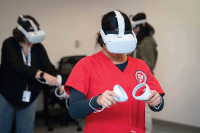Beyond being trusted by the public for their roles in hospitals, ambulatory clinics, schools, and other settings, nurses have a long track record of using their expertise and passion to strengthen the health and well-being of their neighbors. Here are a few examples of their community-focused efforts.
Addressing county-wide issues and child advocacy
Suzanne Canfield, MBA, BSN, RN, a New Mexico Nurses Association member, has been involved in healthcare for a long time. She’s been a nurse’s aide and a chief nursing officer. She’s worked in administration, emergency nursing, maternal-child, and ambulatory surgery. Canfield currently draws on that background and her desire to help those in her community in two key roles.
Nearly 5 years ago, she began volunteering on what’s now called the Los Alamos County Health Council, whose members include local social services providers, representatives from government agencies and business, and other stakeholders.
“I really felt it was important to have nursing represented on a health council,” Canfield said. As a council member, she looks at the needs of Los Alamos County residents identified in a community assessment and assists in recommending activities to meet priority issues. Priorities can range from reducing heart disease to preventing falls in older adults to building resiliency in adolescents.
Regarding the latter, Canfield noted that Los Alamos County has a high percentage of residents with PhDs. “Achievement is a high priority here, which can be challenging for adolescents,” Canfield said. “We have a Youth Resilience Program that participates in the County Health Council and works with teens to give them the tools needed to help prevent substance abuse, bullying, and suicide, among other issues.”
One of the most popular events in the community
is an annual health fair where residents can learn how to maintain or improve their health. For example, they can get their blood pressure and hearing checked, participate in yoga, get their flu vaccination, and have their A1C level tested. Vital health information is then shared with the participant and their healthcare provider.
“One of the things I’ve really tried to emphasize as a nurse is having a good evaluation of the activities we offer in the county,” Canfield said. “Did the activity change participants’ lives in a meaningful way? If not, we need to plan other activities to meet those health priorities.”
Canfield’s own life changed about 2 years ago after hearing a presentation at the health council by a representative from Court Appointed Special Advocates (CASA) First Judicial District, which is aimed at helping children in a three-county area who have been placed in foster care and may have been abused and neglected. She subsequently decided to become a CASA child advocate.
Canfield noted that she works closely with New Mexico Children, Youth, and Families Department caseworkers to ensure foster children are in safe environments and are getting the services they’re entitled to, such as counseling, healthcare, or speech therapy. She attends court hearings, goes on home visits, and writes a report to aid judges in determining whether a child can return home, should remain in foster care, or is eligible for adoption.
“Whenever I’m at a home visit, I’m looking at the environment—is it clean and safe?” Canfield said. “I also am looking at how the child is interacting with the foster parents and any foster siblings. Some children are just naturally shy, so it’s important to differentiate that from a child being intimidated. The goal is always family reunification, but sometimes, because of parents’ ongoing substance use or domestic violence, that is not possible.”
Canfield noted, “Working with one group can lead to other meaningful opportunities. My work on the health council allows me to be involved county-wide. Through CASA, I have the opportunity to make a child’s life better.”
Taking his role and running with it
ANA-Vermont nurse Clayton Wetzel III, BSN, RN, NCSN, became a school nurse after 2 years as a med-surg nurse, a career with a defense firm, and service on submarines in the U.S. Navy. Throughout, he’s been an avid runner.
In terms of his formal role, Wetzel serves as the school nurse at a pre-kindergarten through sixth-grade school in central Vermont with about 140 students. Families in his community are generally healthy, although some struggle with chronic conditions, poverty, and transportation issues that affect healthcare access.
“I spend a fair amount of time working with other members of the healthcare team to make sure students get the care and services they need,” Wetzel said. “We’re really trying to figure out how to help the whole family, whether it’s getting access to a dentist, an audiologist, or specialty care.”
Then there’s Wetzel’s volunteer role. A few years ago, he began a co-ed running club at the school with a fellow employee. Initially, four students from grades 4 through 6 joined the free Mad Valley Runners club. Last year, 42 students participated, and the program expanded to include third graders.
“It’s all about having kids be active, although some of them have become pretty decent runners,” said Wetzel, who serves as both facilitator and coach. Beginning in spring, club members run twice a week for nine weeks. Some of the kids join the club to build their stamina so they can improve their performance in other sports, like soccer or lacrosse. Others just run for fun. Still others have set goals to participate in community running events. For serious runners, Wetzel shares more detailed information about stride lengths, techniques for running up and down hills, and other key aspects of racing.
The club also has strengthened community health and involvement. For example, parents frequently join their children during runs, and two bus drivers volunteer their time to drop off and pick up students so they can run on a nature trail farther from school.
Wetzel has been active in the nursing community through ANA-Vermont and the Vermont State School Nurses’ Association (VSSNA), serving on the latter’s executive committee as its state director to the National Association of School Nurses.
Wetzel has served as the VSSNA webmaster since 2012. And through a microsite he created, as well as Twitter, he shares information with school nurses on issues that can help them in their practice, such as news about an insulin pump that’s failed, questions about delegation, or how to generate reports from the school’s electronic health record.
“I became a nurse to help people,” Wetzel said. “School nurses are very autonomous. So it’s important that we stay connected and help each other by sharing our knowledge.”
From patient-centered care to sheltering pets
Amy Swarr, MBA, BSN, RN, is a collaborative care nurse at a physician clinic serving low-to-middle-income residents in rural Windsor County, Vermont. The population she works with typically has chronic conditions, such as heart failure and diabetes, and in some instances, substance use issues.
A key aspect of her role is to ensure that each patient’s healthcare plan is patient-centered and is followed as he or she moves from the inpatient to the clinic to the community setting. As part of the community health team, Swarr also conducts home visits to assess the environment for issues (such as fall risks), identifies community resources, and addresses social determinants of health that may present barriers.
“Education is a key component, because patients aren’t able to self-manage and they may have different priorities than the healthcare team,” said Swarr, an ANA-Vermont member.
When she isn’t connecting patients with resources and care, Swarr engages in a range of efforts to benefit the community. For example, for the past 2 years she ran on the ANA-Vermont team participating in the state Corporate Cup Challenge, which raises money for community organizations.
And one ongoing passion for the past 15 years is animal welfare. She’s currently working with humane and rescue groups to expand the number of people who can foster animals on a short-term basis or with short notice when families are in crisis.
“You don’t want older adults who are suddenly hospitalized to lose their pets, who are not only part of their family, but who also prevent them from being socially isolated,” Swarr said.
She added, “I’ve always considered myself lucky to have ended up in the family that I did, so I try to help in ways that I can.”
From the ER to the beehive
Jen Sheldon, RN, is an emergency nurse at CarolinaEast Medical Center in New Bern, North Carolina, an ANCC Pathway to Excellence® facility. For her, community involvement is a tradition passed on from her father.
Using her nursing expertise, Sheldon helps lead a health clinic that’s associated with the Faith in Action Vision Clinic. Both are sponsored by the Garber United Methodist Church and Vision Service Plan, offered every 2 years, and staffed by volunteers.
“We have the capacity to see 300 people free of charge,” Sheldon said. “We offer blood pressure and blood glucose checks. We also do basic history and physicals and refer people, especially those we identify with borderline blood sugars or as hypertensive, to free clinics.”
A few years ago, she traveled to an orphanage in Russia on a church-sponsored trip. There, she and a physician assistant took the heights and weights of children and created much needed basic, portable health records.
Sheldon, a mother of five, also helps with minor healthcare needs at her children’s school and uses her knowledge as a state-certified beekeeper to support the school’s beekeepers club and manage the hive. (Her husband and 17-year-old daughter also are certified, and her 13-year-old son came up with the idea for the club.) Part of her volunteer role with the beekeepers club is to teach its 30 members and other students about the innerworkings of the hives, bee life cycle, honey extraction, and bees’ positive impact on the environment.
“The children absolutely love it,” Sheldon said. “They see it as helping the planet.”
Sheldon doesn’t see her community involvement as “community service,” but rather as just a part of life. She and her husband also have dealt with some health issues that they got through, in part, with the help of their close-knit community. So giving back and helping out whenever they can is their mantra.
“Community outreach doesn’t have to be with a stethoscope,” Sheldon said. “It’s about compassionate care.”
— Susan Trossman is a writer-editor at ANA.




















